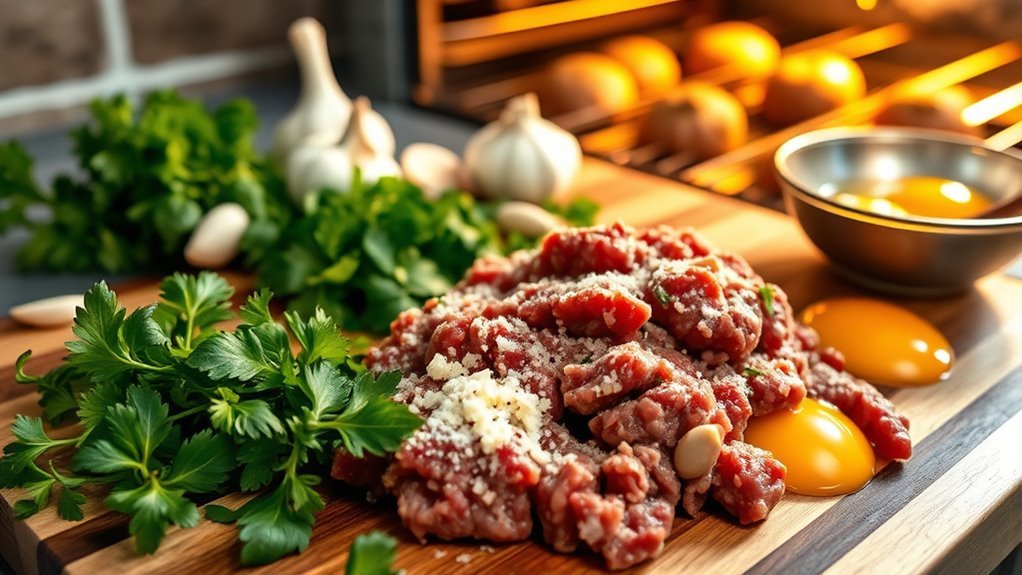To make keto meatballs, start with high-quality ground meat like beef or turkey. Combine it with low-carb binders like almond flour and seasonings such as garlic powder and Italian herbs. Form the mixture into balls and choose your preferred cooking method: bake at 400°F for 20-25 minutes, fry for a crispy exterior, or slow cook with sauce. Serve with zoodles or cauliflower rice, and explore variations and storage tips to enhance your meal. More ideas await!
Ingredients Needed for Keto Meatballs

To create delicious keto meatballs, you’ll need a specific set of ingredients that align with the low-carb lifestyle. Start with high-quality ground meat, but you’ll also need keto meatball seasonings to enhance the flavor. Think garlic powder, onion powder, and Italian herbs; they’ll bring your meatballs to life without adding carbs. For low carb binders, consider using almond flour or crushed pork rinds, which help hold your meatballs together while keeping them keto-friendly. Don’t forget some grated Parmesan cheese to add richness and moisture. Additionally, incorporating cheese varieties like cheddar can further enhance the flavor profile of your meatballs. With these ingredients, you’ll craft meatballs that satisfy your cravings and fit perfectly into your low-carb plan, giving you the freedom to enjoy hearty meals without the guilt.
Choosing the Right Meat

When it comes to making keto meatballs, choosing the right meat is essential for flavor and nutrition. You’ll want to take into account keto-friendly options like beef, pork, or turkey, while also weighing the benefits of grass-fed versus conventional meat. Additionally, the balance between lean and fatty cuts can greatly impact the texture and richness of your meatballs. Incorporating kielbasa as an option can add a savory flavor profile to your meatballs while keeping them keto-friendly.
Types of Keto-Friendly Meat
Choosing the right meat for your keto meatballs is essential, as it not only affects flavor but also aligns with your dietary goals. Here are some excellent keto-friendly options:
| Meat Type | Flavor Profile | Fat Content |
|---|---|---|
| Ground Beef | Rich and savory | High |
| Pork Sausage | Juicy and spiced | Moderate to High |
| Ground Turkey | Mild and versatile | Low to Moderate |
| Ground Lamb | Distinct and bold | High |
| Italian Sausage | Flavorful and herby | High |
Selecting quality beef options and exploring pork alternatives can elevate your meatballs while keeping you within your macro guidelines. Remember, the right meat not only enhances taste but also supports your keto lifestyle. Incorporating high-quality meats into your dishes ensures you receive essential nutrients while maintaining a low carbohydrate intake.
Grass-Fed vs. Conventional
Grass-fed meat has gained popularity over conventional options, and for good reason. When choosing the right meat for your keto meatballs, consider the following:
- Grass-fed benefits: It’s often higher in omega-3 fatty acids and antioxidants, promoting better heart health and reduced inflammation.
- Flavor: Many find grass-fed meat richer and more robust in taste, enhancing your meatball experience.
- Ethical considerations: Grass-fed options typically come from animals raised in better conditions, aligning with conscious eating practices.
On the flip side, conventional meat can have drawbacks, like higher levels of saturated fats and antibiotics. Additionally, the choice of meat can influence your cholesterol levels, as opting for healthy fats is essential in maintaining balanced cholesterol while on a ketogenic diet. By weighing these factors, you can make an informed choice that suits your dietary goals and values.
Lean vs. Fatty Cuts
While you might think that any ground meat will do for keto meatballs, the choice between lean and fatty cuts considerably impacts both flavor and texture. Lean meat, like turkey or chicken, offers a healthier option but can lead to dry meatballs without proper moisture. On the other hand, fatty meat, such as ground beef or pork, provides rich flavor and juiciness, making for a more satisfying bite. A blend of lean and fatty cuts often strikes the perfect balance, giving you the best of both worlds. Consider your personal preferences and dietary needs, but remember that the right fat content enhances the overall taste and guarantees your keto meatballs are both delicious and enjoyable. Additionally, incorporating healthy fats into your meatball recipe can further support your body’s energy needs while in ketosis.
Mixing the Meatball Mixture

Mixing the meatball mixture is an essential step in crafting delicious keto meatballs. To achieve the perfect blend of flavors and textures, you’ll want to focus on proper mixing techniques and ingredient ratios. Here’s how to do it effectively:
- Combine Ingredients: Start by mixing your ground meat with low-carb binders like almond flour or grated cheese.
- Add Spices: Incorporate your favorite herbs and spices to enhance flavor—think garlic powder, onion powder, and Italian seasoning.
- Knead Gently: Use your hands to gently knead the mixture, ensuring everything is well combined without overworking it. Adding healthy fats like olive oil can also improve the texture and richness of your meatballs.
Forming the Meatballs
Once you’ve mixed your meatball mixture to perfection, the next step is forming the meatballs themselves. Here, you’ll want to focus on size consistency to guarantee even cooking. Using different shaping techniques can help, whether you prefer rolling them by hand or using a scoop for uniformity. Additionally, incorporating cheese like cheddar or mozzarella can elevate the flavor while keeping your meatballs keto-friendly.
| Technique | Description | Pros |
|---|---|---|
| Hand Rolling | Forming balls with your hands | Customizable size |
| Cookie Scoop | Using a scoop for uniform shapes | Quick and easy |
| Ice Cream Scoop | Larger portions for hearty meatballs | Great for sharing |
| Measuring Cup | Precise size control | Consistent results |
| Fork Shaping | Molding with a fork | Unique texture |
Experiment with these techniques to find what suits your style best!
Cooking Methods for Keto Meatballs
When it comes to cooking methods for keto meatballs, you’ve got several options to achieve a deliciously satisfying result. Each method offers unique flavors and textures, so you can choose what fits your mood best. Here are three popular techniques:
Explore various cooking methods for keto meatballs, each providing distinct flavors and textures to satisfy your cravings.
- Baking Techniques: Preheat your oven to 400°F (200°C). Place meatballs on a lined baking sheet and bake for 20-25 minutes. This method allows for even cooking and a nice crust.
- Frying Options: Heat oil in a skillet over medium-high heat. Fry the meatballs for about 6-8 minutes, turning occasionally. This gives them a crispy exterior.
- Slow Cooking: For a tender texture, place meatballs in a slow cooker with sauce and cook on low for 6-8 hours. This technique can also help promote effective weight loss by keeping you satisfied with flavorful meals.
Choose your favorite and enjoy!
Serving Suggestions
Keto meatballs can be served in a variety of ways that enhance their flavor and fit seamlessly into your low-carb lifestyle. One popular option is to pair them with a rich marinara or a creamy garlic sauce, both of which complement the meatiness beautifully. Alternatively, try a zesty chimichurri for a fresh twist. As for side dishes, consider serving your meatballs over zucchini noodles or cauliflower rice to keep it low-carb while adding delicious texture. A side of sautéed greens, like spinach or kale, can also boost the nutritional profile of your meal. Additionally, incorporating low-carb grain substitutes can ensure you stay aligned with your keto diet while enjoying diverse flavors. Feel free to get creative with your combinations—experimenting with different sauces and sides can elevate your dining experience while staying true to your keto goals.
Storing and Reheating Leftovers
To guarantee your leftover meatballs remain delicious and safe to eat, proper storage is key. Here are some effective leftover storage and reheating tips:
Proper storage is essential to keep your leftover meatballs delicious and safe for up to 4 days.
- Refrigerate: Store your meatballs in an airtight container in the fridge for up to 4 days. This helps maintain freshness and prevents spoilage.
- Freeze: For longer storage, freeze meatballs in single layers on a baking sheet, then transfer them to a freezer-safe bag. They can last up to 3 months.
- Reheat: When ready to eat, reheat in the oven at 350°F for about 15-20 minutes or microwave for 2-3 minutes, ensuring they reach an internal temperature of 165°F. Additionally, consider pairing your meatballs with cottage cheese for a protein boost and added creaminess.
These simple steps will keep your keto meatballs tasty and ready for your next meal!
Variations to Try
There are plenty of exciting variations you can try with your meatballs to keep your meals interesting and flavorful. If you love a kick, consider spicy variations by adding red pepper flakes or diced jalapeños to the mix. This not only enhances the flavor but also boosts your metabolism. For those who can’t resist cheese, incorporate cheesy additions like shredded mozzarella or Parmesan into the meatball mixture. This creates a creamy texture and rich taste that’s hard to beat. You might also experiment with different herbs and spices, such as basil or oregano, to elevate the flavor profile. With these variations, you can easily customize your keto meatballs to satisfy your cravings while staying on track with your dietary goals.
Frequently Asked Questions
Can I Use Ground Turkey Instead of Beef for Keto Meatballs?
Yes, you can definitely use ground turkey instead of beef for keto meatballs! Ground turkey offers several benefits, including being lower in fat and calories while still providing protein. This can help you maintain your keto diet without sacrificing flavor. Plus, there are plenty of keto meatball variations you can try, like adding herbs, spices, or even cheese to enhance the taste. So, feel free to get creative with your meatball recipes!
How Do I Know When My Meatballs Are Fully Cooked?
To know when your meatballs are fully cooked, check their internal temperature with a meat thermometer; it should reach at least 165°F (74°C). Besides that, look for visual cues: the meatballs should be browned on the outside and firm to the touch. If you see any juices running clear instead of pink, that’s another good sign. Trust these methods for perfectly cooked meatballs, ensuring they’re safe and delicious!
Are There Any Keto-Friendly Binders Besides Breadcrumbs?
Yes, there are several keto-friendly binders you can use instead of breadcrumbs. Almond flour is a popular choice, as it adds a nice texture and flavor. Coconut flour is another option; just remember it absorbs more moisture, so you’ll need to adjust your liquid ingredients accordingly. Both alternatives help bind your meatballs while keeping them low in carbs, allowing you to enjoy your meal without compromising your keto lifestyle.
Can I Freeze Uncooked Meatballs for Later Use?
Yes, you can freeze uncooked meatballs for later use! Freezing meatballs is a fantastic meal prep strategy. Just place them on a baking sheet to freeze individually before transferring them to a freezer bag. This way, you can grab just what you need later. Make sure to label the bag with the date, and they’ll stay fresh for up to three months. It’s a great way to have convenient, keto-friendly meals ready to go!
What Sauces Pair Well With Keto Meatballs?
Keto meatballs pair well with several delicious sauces. You can enjoy them with marinara sauce for a classic taste, or try creamy pesto for a flavorful twist. Garlic butter adds richness, while spicy arrabbiata brings a kick. For a creamy option, Alfredo sauce is perfect, and if you’re craving something tangy, sugar-free BBQ sauce complements them nicely. These sauces not only enhance the flavor but also keep you aligned with your keto goals.


